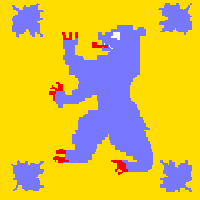The large island of Afristan, while not on most maps (since it is ficticious), is located in the Indian Ocean. As such it is of some importance to Queen Victoria . . . if only to keep it from falling into the hands of a hostile government.
 While nominally ruled by Sultan Omar Mustapha, he really has little control over the peoples of Afristan. In fact, he only truly has control of his island fortress of the city of Flog (located off the mouths of the Cango and Wazu rivers).
While nominally ruled by Sultan Omar Mustapha, he really has little control over the peoples of Afristan. In fact, he only truly has control of his island fortress of the city of Flog (located off the mouths of the Cango and Wazu rivers).(Click on map for larger image. Click twice for much larger image.)
The Sultan also has some minimal control over the districts of Tewfiq, Kamel, Nukar and Urabbi . . . since he has troops (admittedly rather dissatisfied troops) located in the port cities and frontier forts of these districts.
Of course, at his request, some British troops must also be permanently stationed there as well since Sultan Omar Mustapha is much less than universally loved by his troops.
Each port and fort must always have at least one full unit of British troops; and the ports also require an artillery piece and crew; while the forts must have a gatling gun and crew . . . and none of these troops or weapons may be "borrowed" for the "field forces" unless the district is "in rebellion".
Each player will control a small "field force" and be tasked with "keeping the peace" by making an appearance in each district within their area of responsibility. It will take a "month" to "show the flag" in each district . . . and they may only "re-supply" (including filling gaps caused by casualties) in either a port or frontier fort.
At the start of the Campaign (January, 1876), all districts will have a rebellion index of "2" (or more) . . . which will go up for each month not "visited". Most districts will go up by "1" each month . . . (note that this has been changed to 1d6-3 for more unpredictability -- 4/11/11) . . . and will return to a base index of "2" if they have been successfully visited that month.
Note however, those districts with a "trading post" (purple squares on map) will roll 1d8-4 each month and add any positive number to their index; and those districts with a missionary (purple & white "tents" on map) will 1d6-2 points. Finally, any district adjacent to a district "in rebellion" at months' end will go up 1d6 points instead of its normal die roll.
When a "field force" enters a district, the Campaign Master (me) will roll 1d20. If that roll is lower than the current "rebellion index" for that district, it is in rebellion. The difference between that roll and the rebellion index will be the number of units that the player must face.
If that difference is only one unit, no table top battle will take place (unless the field force is quite small). Instead the field force will "win", but must roll dice to determine their own casualties.
If the difference is more than one, a battle will be fought . . . and the other players will play the "natives" . . . thus, over time, everyone will get the chance to play all of the different forces.
If the Player's field force wins, the rebellion is suppressed and the district reverts to an index of "2" (just as if there hadn't been a battle) since the district will no longer be "in rebellion" (and adjacent districts will NOT continue to roll 1d6s, but keeping their current ratings, they will revert to rolling their "normal" die).
However, if the Player's field force is defeated (or withdraws), the district is successfully "in rebellion" and its index (like those of the adjacent districts jumps by 1d6 points (to a maximum of "18"). Field forces which are defeated (or who withdraw) must return to the district that they just came from, which, of course will first roll 1d6 to add to its index and I will roll the d20 to see if they must fight there as well.
Mountains, by the way, are considered to be "impassable", which complicates the route of some field forces.
Well, there's more, but that's enough for now.
(note: some edits made on 5/2/11)
-- Jeff



